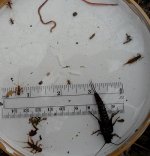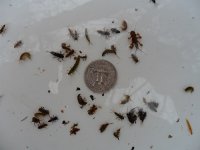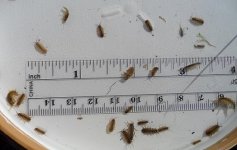Dave_W
Moderator
Staff member
I enjoy seining for aquatic insects. This year, I think I'll try to make this a bit more systematic and allow for comparison through different seasons.
Here's my plan (subject to change):
Survey three characteristic, local wild trout streams at least four times per year. Streams will be Falling Springs, Big Hunting Creek, and Yellow Breeches.
These streams include a "pure" limestoner (FS), a medium sized "semi" limestoner (YB) and a medium sized but fairly fertile freestoner (BHC). These streams all have good populations of wild trout, some stocked fish (a lot in YB), and are popular with fly fishermen.
Will pick out a good riffle with various habitat, conduct a seine sample in the exact spot with the exact kick method, and do this in January, April, July, and October. Macros will be identified and counted (not sure controlling for size, but this would be interesting, esp for mayfly ad stonefly nymphs). Conventional wisdom is that nymphs are larger in springtime before hatching, but how does species and size vary over the year? Are the nymphs fewer and smaller in October? Are caddis more prevalent in the autumn?
I'll re-fresh this thread as the season progresses. . . and we'll see what turns up.
Here's my plan (subject to change):
Survey three characteristic, local wild trout streams at least four times per year. Streams will be Falling Springs, Big Hunting Creek, and Yellow Breeches.
These streams include a "pure" limestoner (FS), a medium sized "semi" limestoner (YB) and a medium sized but fairly fertile freestoner (BHC). These streams all have good populations of wild trout, some stocked fish (a lot in YB), and are popular with fly fishermen.
Will pick out a good riffle with various habitat, conduct a seine sample in the exact spot with the exact kick method, and do this in January, April, July, and October. Macros will be identified and counted (not sure controlling for size, but this would be interesting, esp for mayfly ad stonefly nymphs). Conventional wisdom is that nymphs are larger in springtime before hatching, but how does species and size vary over the year? Are the nymphs fewer and smaller in October? Are caddis more prevalent in the autumn?
I'll re-fresh this thread as the season progresses. . . and we'll see what turns up.






